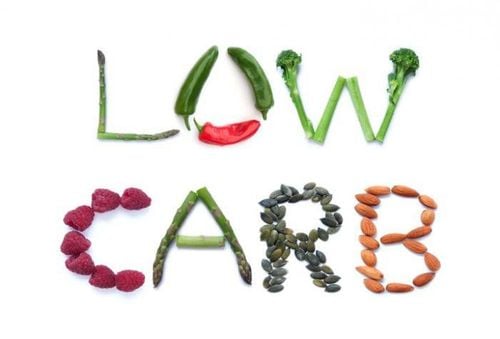This is an automatically translated article.
For a long time, bread has been popular around the world because of its convenience, ease of carrying, nutritional value and delicious taste. However, eating a lot of foods with a high glycemic index like white bread causes weight gain and a higher risk of diabetes.
1. Good and bad carbs in bread
Carbohydrates provide fuel for the body, which is also the main nutrient in bread. The truth is that carbohydrates are not the "enemies" of weight.In a low-carb diet, the problem is not the total carbohydrate intake, but the specific type of carbs. make the mistake of giving up carbs altogether. There are good fats and unhealthy fats, similarly, there are good carbohydrates rich in fiber and unhealthy carbohydrates. Less processed grains contain healthy sources of carbohydrates that provide vitamins, minerals, fiber and antioxidants.In addition, whole grains balance other nutrients that white bread does. No.
A high-fiber, unprocessed, high-carbohydrate diet is considered healthy Consuming whole grains, such as brown bread, crackers, brown rice and quinoa, reduces risk risk of type 2 diabetes, heart disease, inflammation, obesity and some cancers
1.2 Bad carbs Meanwhile, white bread is made from a type of carbohydrate Simple, processed. Their characteristics are fast and easy to digest, but have little nutritional value.

Bánh mì trắng giá trị dinh dưỡng thấp
Foods made with highly processed grains cause blood sugar levels to spike shortly after eating, contributing to the development of type 2 diabetes. The large amounts of simple carbohydrates in white bread also lead to weight gain and an increased risk of heart disease, as well as other chronic diseases.
Processed carbs also lack fiber, making you not feel full after eating. So you will crave more food soon after, especially when blood sugar drops.
2. Refined flour in white bread
When making white bread or white flour, manufacturers process the grain to remove the bran and germ, leaving only the endosperm. Products made with refined flour have a smoother, lighter texture and generally have a longer shelf life.
However, the processing has removed most or all of the fiber, vitamins, and minerals. The remaining endosperm provides only simple carbohydrates, which are easily digested but have little nutritional value.
This can lead to nutritional deficiencies, so manufacturers are now adding some of the nutrients lost to refined white flour, such as folic acid and B vitamins.
However, vitamin supplements are not as good as vitamins of natural origin. Normally, the human body will better absorb and process nutrients from unprocessed sources. Furthermore, fiber, which is essential for digestive and cardiovascular health, is irreplaceable.

Bánh mì trắng đã được loại bỏ hầu hết hoặc tất cả các chất xơ, vitamin và khoáng chất
In addition, preservatives that keep bread fresh longer are also not good for health. In addition, many white breads contain sugar or sugar substitutes, such as corn syrup, sucrose, glucose and fructose, in relatively high proportions. Consuming too much of the processed flour and additives in white bread can contribute to obesity, heart disease and diabetes.
3. Increased risk of diabetes
According to a new study, eating white bread is associated with an increased risk of type 2 diabetes. Based on the participants' eating habits and diabetes diagnoses, the researchers concluded that White bread is the food most associated with the incidence of diabetes.
Pay particular attention to the glycemic index GI of a food - a tool that measures the impact a dish has on blood sugar. Similar to cakes and cookies, the high GI of white bread raises blood sugar significantly. While low GI carbs, including vegetables and beans, have less of an effect.
A high GI diet also leads to insulin resistance (a decrease in the body's ability to respond to the hormone insulin), which is the cause of diabetes.
According to researchers, people who eat a lot of white bread - about more than 17 slices per week, have the highest risk of diabetes. Meanwhile, people who ate a lot of natural sugars from sweet fruits, magnesium and total carbohydrates had a lower risk of diabetes.
On the other hand, when considering the rate at which blood sugar rises, also known as the glycemic response, after eating white bread, the way the body reacts will vary from person to person. In particular, a few people don't have an intense blood sugar reaction to white bread. Others react badly to white bread. This means that there is no one-size-fits-all diet. The menu needs to be personalized to ensure the most optimal.

Người dùng nhiều bánh mì trắng có nguy cơ cao mắc bệnh tiểu đường
4. Risk of being overweight or obese
If you are monitoring your weight, you also need to be aware of your white bread consumption habits. Regular white bread makes you more likely to be overweight or obese than whole grain bread, according to a new study.
Specifically, people who ate only white bread and ate more than 2 servings per day were 40% more likely to be overweight or obese than those who ate less than 1 serving of white bread per week. Research also shows that eating more refined foods, like white bread and white rice, increases belly fat more. While eating a lot of meat and potatoes will also cause weight gain, the fat is evenly distributed throughout the body.
On the other hand, there was no link between eating whole grain bread and being overweight or obese. This is thanks to the carbohydrates, fiber content and other healthy ingredients in whole grain bread. When eating the same number of calories each day, but the carbs that come mainly from refined, packaged and processed foods, or starchy vegetables like potatoes, three times more waist circumference (about 1.3cm) increased. per year) compared with eating unrefined and less processed "whole" foods.
In summary, consuming more than 2 servings of white bread per day is directly associated with the risk of being overweight or obese. A high glycemic index of white bread also increases the risk of diabetes. Changing from white bread to low GI whole grain bread in the menu may reduce the risk of diabetes. People who follow this eating plan also often don't gain weight, or gain little or nothing, and have a reduced risk of cancer, heart disease, and other conditions.
References: health.harvard.edu; medicalnewstoday.com; webmd.com













